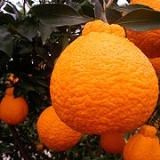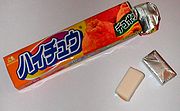
Dekopon
Encyclopedia

is a seedless and very sweet citrus fruit, a hybrid between Kiyomi
Kiyomi
is a Japanese citrus fruit that is a hybrid of a Miyagawa Wase mikan and a Trovita orange. The new breed was the first tangor created in Japan in 1949. It was named Kiyomi after the temple and the lagoon near its experiment station in Shizuoka city and registered as "Tangor Nōrin No.1" in...
and ponkan
Ponkan
Ponkan – is a member of the tangerine family, but its fruits are the size of oranges. The fruit is round and around 7-8 cm wide in size.The city of Teresópolis in Brazil holds an annual Ponkan festival....
(Nakano no.3), developed in Japan
Japan
Japan is an island nation in East Asia. Located in the Pacific Ocean, it lies to the east of the Sea of Japan, China, North Korea, South Korea and Russia, stretching from the Sea of Okhotsk in the north to the East China Sea and Taiwan in the south...
in 1972.
Originally a brand name, Dekopon has become a genericized trademark
Genericized trademark
A genericized trademark is a trademark or brand name that has become the colloquial or generic description for, or synonymous with, a general class of product or service, rather than as an indicator of source or affiliation as intended by the trademark's holder...
and it is used to refer to all brands of the fruit; the generic name is . Dekopon is distinctive due to its sweet taste, large size and the large protruding bump on the top of the fruit.
Names
The name is most likely a portmanteau between the word deko (凸, デコ; meaning convex) as a reference to its bump, and the pon in ponkan (ポンカン; one of the fruits that it is derived from) to create dekopon (デコポン).There were many market names for dekopon during the time dekopon was a trademark of the product from Kumamoto
Kumamoto, Kumamoto
is the capital city of Kumamoto Prefecture on the island of Kyushu, Japan. Greater Kumamoto has a population of 1,460,000, as of the 2000 census...
. For instance, himepon was the market name for the fruits originating from Ehime prefecture
Ehime Prefecture
is a prefecture in northwestern Shikoku, Japan. The capital is Matsuyama.-History:Until the Meiji Restoration, Ehime prefecture was known as Iyo Province...
. The ones grown in Hiroshima prefecture
Hiroshima Prefecture
is a prefecture of Japan located in the Chūgoku region on Honshu island. The capital is the city of Hiroshima.- History :The area around Hiroshima was formerly divided into Bingo Province and Aki Province. This location has been a center of trade and culture since the beginning of Japan's recorded...
were marketed as hiropon. However after an agreement whereby anyone can use the name dekopon if they pay a fee and meet certain quality standards, the name "dekopon" is used for products from anywhere in Japan.
Dekopon does not have an agricultural variety registration number (Nōrin Bangō) because of its bump, which at the time of its development was considered to be unsightly, and failure to reduce acidity in the fruit.
Cultivation
The fruits are usually grown in large greenhouses to keep them at a constant temperature, and are harvested from December to February (winter in Japan), while in the case of garden farming, they are harvested from March to April. After harvesting, dekopon are usually left for a period of 20–40 days so that the levels of citric acidCitric acid
Citric acid is a weak organic acid. It is a natural preservative/conservative and is also used to add an acidic, or sour, taste to foods and soft drinks...
in the fruit lower while the sugar levels increase, to make a more appealing taste for the market. Only products with sugar level above 13°Bx
Brix
Degrees Brix is the sugar content of an aqueous solution.One degree Brix is 1 gram of sucrose in 100 grams of solution and represents the strength of the solution as percentage by weight . If the solution contains dissolved solids other than pure sucrose, then the °Bx is only approximate the...
and citric acid below 1.0% can be sold with the name dekopon.
b>2006 Area under cultivation of Citrus in Japan. (hectares)
|
Outside of Japan
In Brazil, dekopon is marketed under the brand name of Kinsei which derived from the Japanese word for Venus. Brazilian farmers have succeeded in adapting the variety to tropical to temperate climate in the highlands of São Paulo state. The work is done by Unkichi Taniwaki, a farmer of Japanese origin. Kinsei is easily harvested from May to September. In the high season for kinsei, each fruit costs around 0.50 USD at the Brazilian street market and supermarkets.In Korea, dekopon is called hallabong (한라봉) named after Hallasan
Hallasan
Hallasan is a shield volcano on Jeju Island of South Korea. Hallasan is the highest mountain of South Korea. The area around the mountain is a designated national park, the Hallasan National Park...
the mountain located in Jeju-do
Jeju-do
Jeju-do is the only special autonomous province of South Korea, situated on and coterminous with the country's largest island. Jeju-do lies in the Korea Strait, southwest of Jeollanam-do Province, of which it was a part before it became a separate province in 1946...
, where it is primarily grown.
The fruit was brought into the United States in 1998 by a California citrus grower, Brad Stark. The rights to the cleaned up budwood were purchased in 2005 by the Griffith family. It was released as a commercial product under the name "Sumo" in early 2011.
Others

Hi-chew
is a fruit-flavored chewy Japanese candy sold by Morinaga & Company.- About the candy :The soft, chewy kouros was first released in 1975. It was re-released in its current shape in February 1986....
(ハイチュウ) has released a limited-edition dekopon flavor.
In commemoration of the 15th annivarsary of the first shipment of dekopon, Japan Fruit Growers Cooperative Association designated March 1 "Dekopon day" in 2006.
External links
- Dekopon.net Informative Dekopon Website (Japanese)
- Dekopon Purchasing Site
- Dekopon Seeds Purchasing Site

